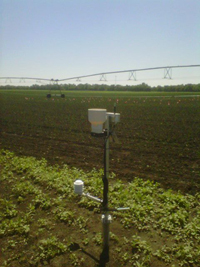Background on the Manitoba Potato Weather Network & Models
Manitoba Agriculture, Food and Rural Initiatives (MAFRI) in collaboration with Keystone Potato Producers Association (KPPA) have been providing a potato late blight disease forecast since 1997. Starting 2011, Weather INnovations Incorporated is partnering with these groups to assist in the operation of the weather monitoring network and in the delivery of information to growers and the potato industry.
DSV:
The late blight model was adapted from an original Wisdom-Tomcast forecast model. Over several years of operation, the model has been calibrated to reflect Manitoba conditions. The disease severity value (DSV) represents the degree of risk that a late blight infection will occur. A DSV of 18 is the initial threshold for disease occurrence if the inoculum is present in the area. Once the accumulation exceeds 18, the 7-day change in DSV is most important. A 7-day change of 0-3 is considered low risk, a change of 4-8 is moderate risk, and a change of 9 or more is high risk.

P-Days:
Temperature plays a key role in the growth and development of potatoes. The timing of important growth stages proceeds in direct proportion to the accumulated temperature experienced by the crop. P-days are a measure of useful heat for the growth and development of potatoes. P-days are calculated using the daily minimum and maximum air temperatures. The accumulation of P-days during any one day is modified by dividing the day into four parts to account for diurnal temperature variations. The minimum, optimum, and maximum developmental temperatures are 7°C, 21°C, and 30°C respectively. For Russet Burbank, the following table shows the approximate relationship between P-Days and crop development. P-Day accumulation starts at average emergence.
- 0–170 Vegetative Growth
- 170-280 Tuber Initiation
- 280-640 Tuber Bulking
- 640-Frost Tuber Maturity
Crop Water Demand:
The estimate of crop water demand is based on two main criteria – weather parameters and crop characteristics. The weather controls the atmospheric demand for moisture. Heat and solar radiation provides energy for evaporation. Relative humidity influences the gradient of saturated air within the leaf’s stomata to the drier surrounding air. Wind turbulence controls the rate at which moist air is carried away. Therefore, crop water demand will be greatest on a hot, dry, and windy day. The main crop factors that influence the rate of water demand include the crop type, stage, size, vigour, and root depth. Depending on how a crop compares with the regional average, growers should consider that the actual water demand from a specific crop could be significantly more or less than the estimates that are provided.
In order to estimate the crop water demand, the potential evapotranspiration is first calculated using the Penman-Monteith equation as described in FAO Irrigation and drainage paper 56 (Allen et al. 1998). Reference crop ET or ET0 is the estimated ET from a well-watered hypothetical grass reference crop. A crop coefficient (KC) is applied to the ET0 to account for differences between the ET of the two surfaces. The daily ET is calculated based on 24-hour Tmax, Tmin, RHmax, RHmin, wind speed, and solar radiation. Stations that are not equipped with wind or radiation sensors will use the data from the nearest station with those sensors.


